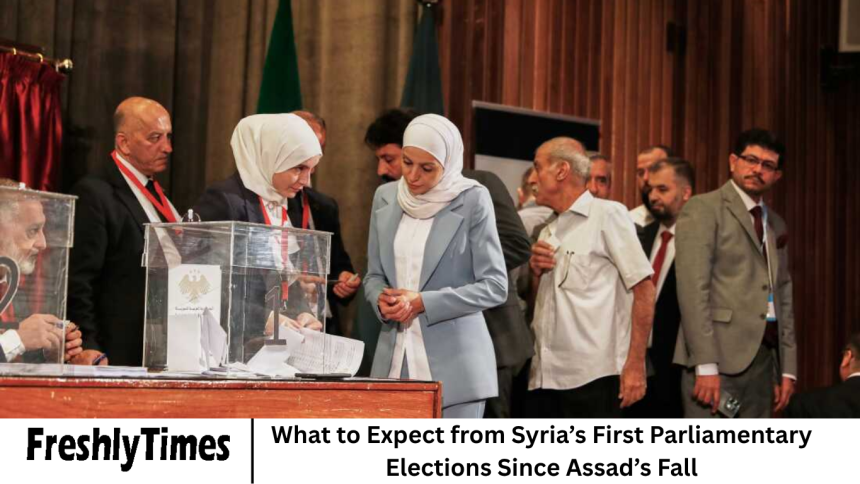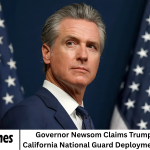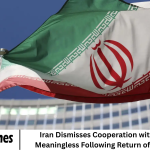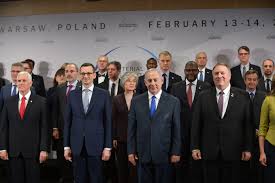For the first time in more than a decade, Syria is poised to hold parliamentary elections without Bashar al-Assad’s shadow looming over the process. This milestone marks a dramatic shift in a nation that has endured civil war, political repression, foreign interventions, and a complete transformation of its social fabric.
- The Historical Context: From Assad’s Rule to Political Transition
- The New Political Landscape: Transitional Authority and Reform
- A Multi-Party System:
- Electoral Commission Oversight:
- Decentralization Efforts:
- Inclusion of Exiles:
- Transitional Justice Mechanisms:
- The Major Political Players
- The National Reform Bloc (NRB):
- The Syrian Democratic Front (SDF):
- The Damascus Renewal Party:
- The Justice and Freedom Alliance:
- Independent Candidates:
- Challenges Ahead: Security, Infrastructure, and Trust
- International Reactions and Geopolitical Stakes
- The Role of Syrian Civil Society and Media
- Possible Outcomes and Scenarios
- The Path Forward: Rebuilding a Nation
- Frequently Asked Question
- Conclusion
These elections—expected to take place amid cautious optimism and significant logistical challenges—are not merely about selecting representatives. They symbolize the potential rebirth of Syria’s democratic institutions and a national reckoning with years of authoritarian rule.
This article delves deep into what Syrians and the world can expect from these historic elections—the political landscape, the major players, international stakes, and the profound implications for the future of the Middle East.
More Read: Governor Newsom Claims Trump Ordered California National Guard Deployment to Oregon
The Historical Context: From Assad’s Rule to Political Transition
Syria’s modern political identity has long been intertwined with the Assad dynasty. Hafez al-Assad seized power in 1970 through a coup and ruled with an iron grip for three decades.
His son, Bashar al-Assad, inherited the presidency in 2000, initially promising reform but soon replicating—and even intensifying—his father’s authoritarian governance.
Under Bashar’s leadership, Syria’s political system was characterized by:
- A one-party state dominated by the Ba’ath Party.
- The suppression of dissent and control of the press.
- A vast intelligence network overseeing public and private life.
- Elections that were nominally democratic but tightly choreographed.
The 2011 Arab Spring sparked hope for change, but Assad’s brutal crackdown turned peaceful protests into a devastating civil war. The conflict drew in multiple international actors—Russia, Iran, Turkey, and the United States—transforming Syria into a geopolitical battleground.
After years of bloodshed, shifting alliances, and international diplomacy, Assad’s downfall came gradually. Military fatigue, economic collapse, internal defections, and waning foreign support eroded his power.
In 2023, following internal negotiations and external pressure, Assad’s government was dissolved, paving the way for a transitional authority. Two years later, Syria stands at a crossroads—its first parliamentary elections since the fall of the Assad regime now represent both a symbol of hope and a test of resilience.
The New Political Landscape: Transitional Authority and Reform
The transitional government, established under the “Damascus Framework Agreement” of 2023, has been tasked with steering Syria toward democratic governance.
This framework, brokered by the United Nations, Turkey, and a coalition of Arab League members, introduced several reforms that make these elections unprecedented in Syrian history:
A Multi-Party System:
The ban on independent political movements has been lifted, allowing more than 30 parties to register. These include secular reformists, Kurdish representatives, Islamist moderates, and civic coalitions emerging from former opposition groups.
Electoral Commission Oversight:
For the first time, Syria’s elections will be overseen by an independent electoral commission with limited UN monitoring.
Decentralization Efforts:
The new constitution emphasizes regional representation to address the grievances of historically marginalized areas like Idlib, Raqqa, and the Kurdish northeast.
Inclusion of Exiles:
Millions of Syrian refugees in neighboring countries and Europe have been granted limited voting rights through international coordination.
Transitional Justice Mechanisms:
Candidates with proven ties to war crimes or human rights abuses under Assad’s regime are barred from running.
Despite these positive developments, skepticism remains. Many Syrians question whether these reforms can undo decades of entrenched corruption, sectarian division, and institutional decay. Yet, even cautious optimism represents a dramatic departure from the fear-driven politics that defined the Assad era.
The Major Political Players
The upcoming elections feature a diverse—albeit fragmented—array of political forces competing for influence:
The National Reform Bloc (NRB):
Composed of technocrats, moderate Islamists, and former opposition leaders, the NRB seeks to establish a modern, pluralistic government rooted in economic reform and reconciliation.
The Syrian Democratic Front (SDF):
A coalition representing Kurdish and Arab factions in northern Syria. The SDF advocates for federalism, minority rights, and the integration of autonomous regions into the national framework.
The Damascus Renewal Party:
Led by former Ba’ath Party reformists, this group positions itself as a bridge between old and new political structures, pledging stability while distancing itself from Assad-era excesses.
The Justice and Freedom Alliance:
An umbrella of civil society movements, academics, and activists, the alliance campaigns for constitutional reform, gender equality, and transitional justice for war victims.
Independent Candidates:
A growing number of independents—especially youth activists and business leaders—are contesting local seats, signaling a generational shift in Syrian politics.
The diversity of candidates underscores both the promise and peril of Syria’s new democracy: inclusivity comes with fragmentation, and unity remains elusive.
Challenges Ahead: Security, Infrastructure, and Trust
While the elections carry symbolic weight, the logistical and security challenges are immense.
Security Instability
Certain regions, particularly in the northwest and along the Iraqi border, remain volatile due to lingering insurgent activity. Although large-scale violence has subsided, sporadic clashes between militia groups and remnants of extremist factions pose a risk to voter turnout and election integrity.
Destroyed Infrastructure
Decades of war have left Syria’s infrastructure in ruins. Many polling stations are being established in makeshift facilities—schools, mosques, and tents in refugee camps.
Displacement Crisis
Over 6 million Syrians remain internally displaced, and another 5 million live as refugees abroad. Ensuring their participation poses logistical and legal hurdles, despite the government’s commitment to inclusivity.
Trust Deficit
Perhaps the biggest challenge is psychological. After decades of rigged elections, many Syrians remain skeptical about the legitimacy of any political process. Building trust in institutions—especially the judiciary and electoral commission—will take years, not months.
International Reactions and Geopolitical Stakes
The international community is watching closely, with the elections seen as a litmus test for Syria’s reintegration into global diplomacy.
The United Nations
The UN has cautiously endorsed the process, emphasizing the need for transparency and inclusivity. While it stops short of declaring full recognition, it has sent limited observers to key provinces.
The Arab League
Having readmitted Syria in 2024, the Arab League views the elections as a necessary step toward restoring Syria’s sovereignty and regional role.
The United States and European Union
Both have expressed cautious optimism, linking future aid and reconstruction support to the election’s credibility. Washington insists that any new government must uphold human rights and distance itself from past authoritarian structures.
Russia and Iran
Both nations, once Assad’s staunch allies, have adopted a pragmatic stance. They seek to retain influence while adapting to the new political order. Moscow has already initiated diplomatic overtures to several emerging Syrian parties, particularly those with secular leanings.
Turkey
An influential regional player, Turkey’s primary interest lies in ensuring stability along its border and protecting its influence over northern Syria’s Kurdish regions.
Israel
Though not directly involved, Israel’s defense establishment remains vigilant, fearing that instability in southern Syria could reignite border tensions.
This complex web of interests means that Syria’s parliamentary elections are not merely a domestic affair—they are a geopolitical balancing act with implications far beyond Damascus.
The Role of Syrian Civil Society and Media
Civil society organizations—many operating underground during the Assad years—are now at the forefront of promoting voter education, transparency, and social reconciliation. Independent journalists and digital platforms have emerged as powerful tools for civic engagement, particularly among the youth.
For the first time, Syrians are engaging in open political debates online and on community radio stations. Grassroots campaigns are tackling issues such as:
- Women’s participation in politics
- Youth unemployment
- Post-war reconstruction policies
- Human rights documentation
While media freedom is still fragile, the shift from state propaganda to pluralistic discourse represents one of Syria’s most profound cultural transformations.
Possible Outcomes and Scenarios
Predicting the outcome of Syria’s first post-Assad elections is challenging. Three broad scenarios are emerging:
Moderate Coalition Victory
A coalition of reformist and civic parties could secure a parliamentary majority, setting the stage for gradual democratic consolidation. This outcome would likely attract international investment and accelerate reconstruction.
Fragmented Parliament
No single bloc gains dominance, leading to a fragile coalition government. While democratic in form, such a parliament could struggle with policy paralysis and internal divisions.
Resurgence of Old Elites
If remnants of the old regime manipulate the process through influence or intimidation, the elections could merely rebrand the past, undermining public faith in reform.
Regardless of the outcome, one fact remains: Syria’s political evolution is now irreversible. The psychological and institutional barriers that once upheld Assad’s rule have cracked beyond repair.
The Path Forward: Rebuilding a Nation
Beyond politics, Syria’s rebirth hinges on reconstruction, justice, and reconciliation.
Reconstruction and Economy
The war devastated Syria’s economy—once one of the most diversified in the region. Rebuilding will require billions in international aid, the revival of trade networks, and investment in energy and agriculture.
Justice and Reconciliation
Addressing war crimes and human rights abuses remains crucial. The transitional justice commission has begun documenting atrocities, but genuine reconciliation will require time, empathy, and inclusivity.
Education and Youth Empowerment
With over half the population under 30, empowering youth through education and civic participation will be key to sustaining democracy.
Women’s Role
Women played critical roles during the conflict—as activists, aid workers, and community leaders. Their inclusion in parliament and policy-making will determine the moral compass of the new Syria.
Frequently Asked Question
When are Syria’s parliamentary elections scheduled to take place?
The elections are slated for early 2026, following months of voter registration, candidate verification, and international coordination under the transitional framework.
Who is overseeing the electoral process?
An independent Syrian Electoral Commission, assisted by limited United Nations observers, will manage and monitor the elections to ensure transparency.
Are former members of Assad’s regime allowed to participate?
Candidates with verified records of corruption or human rights abuses under the Assad regime are barred from running, although former Ba’ath Party reformists may contest.
Will refugees be able to vote?
Yes, Syrian refugees in countries such as Turkey, Lebanon, and Germany will have limited voting rights through internationally supervised polling stations.
How many political parties are competing?
Over 30 registered parties are expected to participate, ranging from secular reformists to Kurdish federalists and civic alliances.
What role does the international community play?
The UN, EU, and Arab League are providing technical support and limited oversight. Western nations have tied future reconstruction aid to credible electoral outcomes.
What is at stake for Syria’s future?
These elections will determine whether Syria transitions toward stable democracy or risks slipping back into authoritarianism and political fragmentation. The results will shape the nation’s reconstruction, foreign relations, and identity for generations.
Conclusion
Syria’s first parliamentary elections since Assad’s fall symbolize the rebirth of a nation long torn apart by dictatorship and war. They offer no guarantees—only possibilities. The path ahead is uncertain, riddled with political, social, and logistical challenges.
Yet, for millions of Syrians, these elections represent something they have not felt in years: hope.Hope that their voices might finally matter.Hope that their sacrifices were not in vain. Hope that a new Syria—free, inclusive, and sovereign—can rise from the ashes of tyranny.














